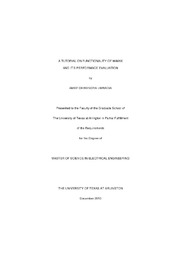
ATTENTION: The works hosted here are being migrated to a new repository that will consolidate resources, improve discoverability, and better show UTA's research impact on the global community. We will update authors as the migration progresses. Please see MavMatrix for more information.
Show simple item record
| dc.contributor.author | Umradia, Amay Dhirendra | en_US |
| dc.date.accessioned | 2011-03-03T21:51:56Z | |
| dc.date.available | 2011-03-03T21:51:56Z | |
| dc.date.issued | 2011-03-03 | |
| dc.date.submitted | January 2010 | en_US |
| dc.identifier.other | DISS-10902 | en_US |
| dc.identifier.uri | http://hdl.handle.net/10106/5455 | |
| dc.description.abstract | Recently, there have been tremendous developments on wireless communication technology which have predicted to replace the wirelined system and provide incredible bandwidth to the consumers. The IEEE standard for this technology is known as 802.16e (Mobile WiMAX) which was officially published in the year 2006. WiMAX would provide broadband access to rural and developing countries where the option of DSL, cable and Wi-Fi is unavailable. This Thesis provides a tutorial overview of 802.16. The information for this article is gathered from The Institute of Electrical and Electronics Engineers (IEEE) website, the WiMAX forum website and other resources on the internet. WiMAX is abbreviated as Worldwide Interoperability for Microwave Access which provides broadband connectivity by connecting to the Internet Service Provider even when you are roaming outside home. This article starts with Roadmap of 4G technology and later with different features of WiMAX. Features like Physical layer, Network Reference Model and MAC layer with QoS architecture form the basis of WiMAX. A brief overview of network entry procedures is followed by one of most widely used tool for studying the performance of existing systems. It is known as Optimized Network Evaluation Tool (OPNET). The article also covers the most recently updated information that is going on the market about the battle between Long Term Evolution (LTE) and WiMAX and the opinion. Also, it speaks about the most recent development to be deployed in late 2014 known as WiMAX 2.0 or Release 2 which has amendments and enhancements to the current WiMAX. Last section is very interesting as it gathers some information comparing the various links and its pros and cons and the answer to the awaited question of whether WiMAX will replace DSL or not. | en_US |
| dc.description.sponsorship | Dillon, William E. | en_US |
| dc.language.iso | en | en_US |
| dc.publisher | Electrical Engineering | en_US |
| dc.title | A Tutorial On Functionality Of WiMAX And It's Performace Evaluation | en_US |
| dc.type | M.Engr. | en_US |
| dc.contributor.committeeChair | Dillon, William E. | en_US |
| dc.degree.department | Electrical Engineering | en_US |
| dc.degree.discipline | Electrical Engineering | en_US |
| dc.degree.grantor | University of Texas at Arlington | en_US |
| dc.degree.level | masters | en_US |
| dc.degree.name | M.Engr. | en_US |
Files in this item
- Name:
- Umradia_uta_2502M_10902.pdf
- Size:
- 7.052Mb
- Format:
- PDF
This item appears in the following Collection(s)
Show simple item record


